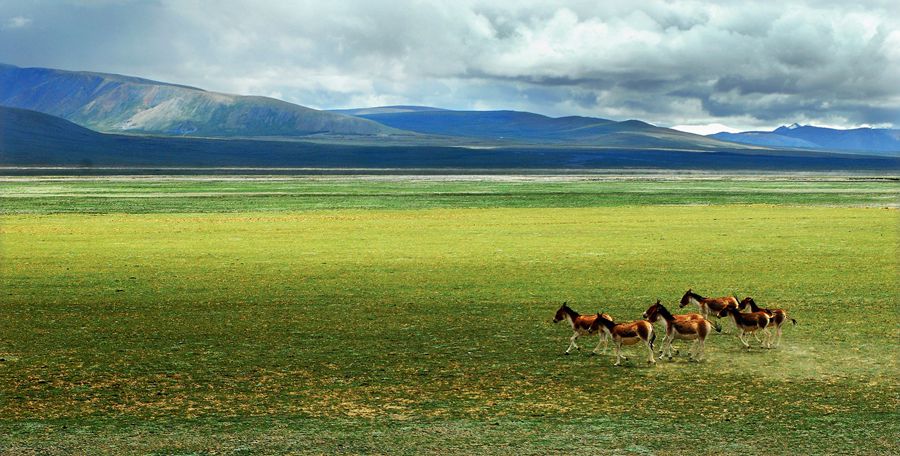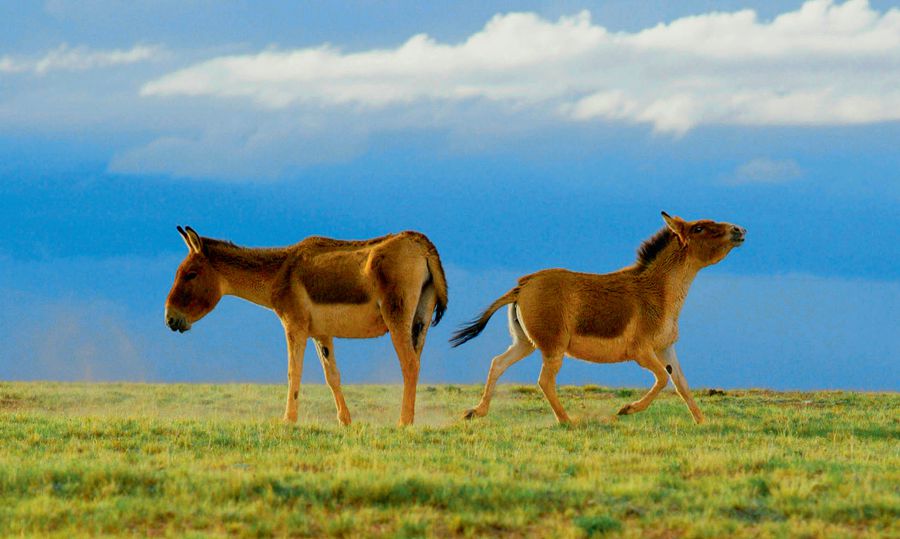THE Tibetan wild ass (Equus kiang) is widespread in the Qinghai-Tibet Plateau. It is placed in the LC (least concern) category in the IUCN (International Union for Conservation of Nature) Red List of Threatened Species and listed in Appendix I of CITES (Convention on International Trade in Endangered Species of Wild Fauna and Flora, also known as the Washington Convention). In 1988, the Tibetan wild ass was listed by the Chinese government in the first group of wildlife under first class protection at national level.
Traits and Distribution
The Tibetan wild ass is a large mammal of the equidae (horse) family and also the largest onager. It looks similar to Equus hemionus with a short head, long ears that are able to rotate, and an obtusely-rounded black snout. Local people also refer to it as “wild horse,” because it has a body and hooves larger than those of domestic donkeys. It has an average height at the withers of 140 cm, a body length of more than 200 cm and a weight of 300 to 400 kilograms. Its body is covered with reddish brown hair. Its upper snout, under neck, breast, belly, and four limbs are covered with white hair, and the tip of the ears, dorsal spine lined with dark hair.

The Tibetan wild ass is a good runner and highly alert. It has an acute sense of hearing, smell, and sight, which enables it to be aware of its surroundings for hundreds of meters. If a Tibetan wild ass finds any creature is approaching or an enemy is trying to attack, it will first raise its head to look around, staring at the threat for a while, and then, dash away. Since the highway was built in the Qinghai-Tibet Plateau, the Tibetan wild ass has developed a new habit of racing alongside cars. It can run for tens of minutes following the car at a speed of 60 kilometers per hour, 40 to 50 kilometers in one breath. When it catches up with the car, it will keep running until surpassing the car and leaving it behind at a distance, then the animal stops to watch and starts to run again. However, it is this habit that easily makes them targets for poachers.
The Tibetan wild ass mostly lives in alpine deserts of 4,000 to 7,000 meters above sea level in the Qinghai-Tibet Plateau, and it loves cogongrass, sedge, and wormwood. Its habitats can be found in Qinghai, Gansu, Xinjiang, Tibet and Sichuan. To get food and water, they migrate over short distances with the change of seasons. In summer, they live in high mountains of over 5,000 meters above sea level, and in winter, they move to lower-altitude places.
Habits and Reproduction
Tibetan wild ass is generally a gregarious animal, usually living in groups of five to eight or 20 to 30 members. A male donkey leads the group wandering around the places where there is enough food and water but less human interference. In the Altun Mountain Nature Reserve in Xinjiang Uygur Autonomous Region, there are usually 100 to 200 members in a Tibetan wild ass group, while in Ha’erteng Basin in the northern Qaidam Basin, it is common to find the Tibetan wild ass live alone.

When Tibetan wild asses are not disturbed, they like to walk in a single file along a fixed route, leaving a “donkey path” that is peculiar to them around the grassland and water sources. The Tibetan wild ass is extremely tolerant of drought and can live without water for several days. They are the best scavengers for seeking out water. During drought, they will dig a well in the places with a high water table by the river. They dig a huge puddle around 50 cm deep, which is called “donkey well” by local herdsmen. These puddles offer water to not just the Tibetan wild ass, but also other local wild animals like the Tibetan antelope.
The mating and breeding season of the Tibetan wild ass varies with the climate of their habitats, and starts from July to September. During the mating and breeding season, the males get irritable and frequently hiss. The male Tibetan wild asses compete with each other for the mating right. The winning male governs the whole group, and kicks and bites the dissenters.
In July of the following year, the female Tibetan wild ass gives birth to a single foal. The adult will protect and take good care of the foal. When a foal fails to climb up to the bank, two adults carry it on the shoulder and push it to the bank. The foal grows very fast. They weigh up to 35 to 40 kg at birth, and get sexually mature at three. The Tibetan wild ass usually lives for 20 years.
Tibetan wild ass has an extraordinary vitality. They spend most of the time in the alpine desert where there are few natural enemies. However, when they move to the lake areas of lower altitudes for abundant water and grass in the breeding season, their natural enemies (mainly the wolf, snow leopard, and Eurasian lynx) are waiting there for them. It is at that time that the elderly, the weak, and the stray get killed.
Domestication and Protection
Tibetan wild ass is characterized by stamina, being smart, tolerant of crude feed, and hard-working, and their steady lope. They can withstand violent storms and are used for carrying loads and passengers, turning millstones, ploughing, sowing, and so on. As early as 3,000 BC, the Tibetan wild ass had been domesticated and employed by humans, earlier than domesticated horses.
However, the Tibetan wild ass has never been domesticated entirely. To give full play to their advantages, people crossbreed them with other livestock to create new breeds. For example, the bay-and-white “dappled horse” is a crossbreed of the Tibetan wild ass and domestic horse. This horse is characterized by large body and great strength, and the locals use it as carrier or ride on it.
In the 1980s, food shortage caused by overgrazing and frequent poaching threatened the survival of the Tibetan wild ass. To protect the species, the Chinese government has taken timely measures such as putting it under first class protection at national level, issuing strict bans on hunting in all forms, and establishing reserves to restrict overgrazing. Due to those protective measures, the Tibetan wild ass population has steadily increased.
Researchers estimated there were about 56,000 Tibetan wild asses in 1989 and approximately 80,000 in 1998. According to statistics of the World Widelife Fund (WWF), there are large Tibetan wild ass populations in northern Chabug Township of Gerze County and northwestern Nyima County in Ngari Prefecture of Tibet, and the number of Tibetan wild asses in some groups reaches over 500. Currently, there are nearly 60,000 Tibetan wild asses in Chang Tang National Nature Reserve in Ngari Prefecture.
Therefore, researchers believe that the number of Tibetan wild ass has surpassed 100,000, and wildlife conservationists are discussing whether the Tibetan wild ass should still be kept on the list of wildlife under first class protection at national level. However, it is agreed by all that we should set up the habitats of the Tibetan wild ass as national nature reserves and continue to protect the whole ecosystem in which they live.
JIANG FUMEI is a Beijing-based freelancer.

